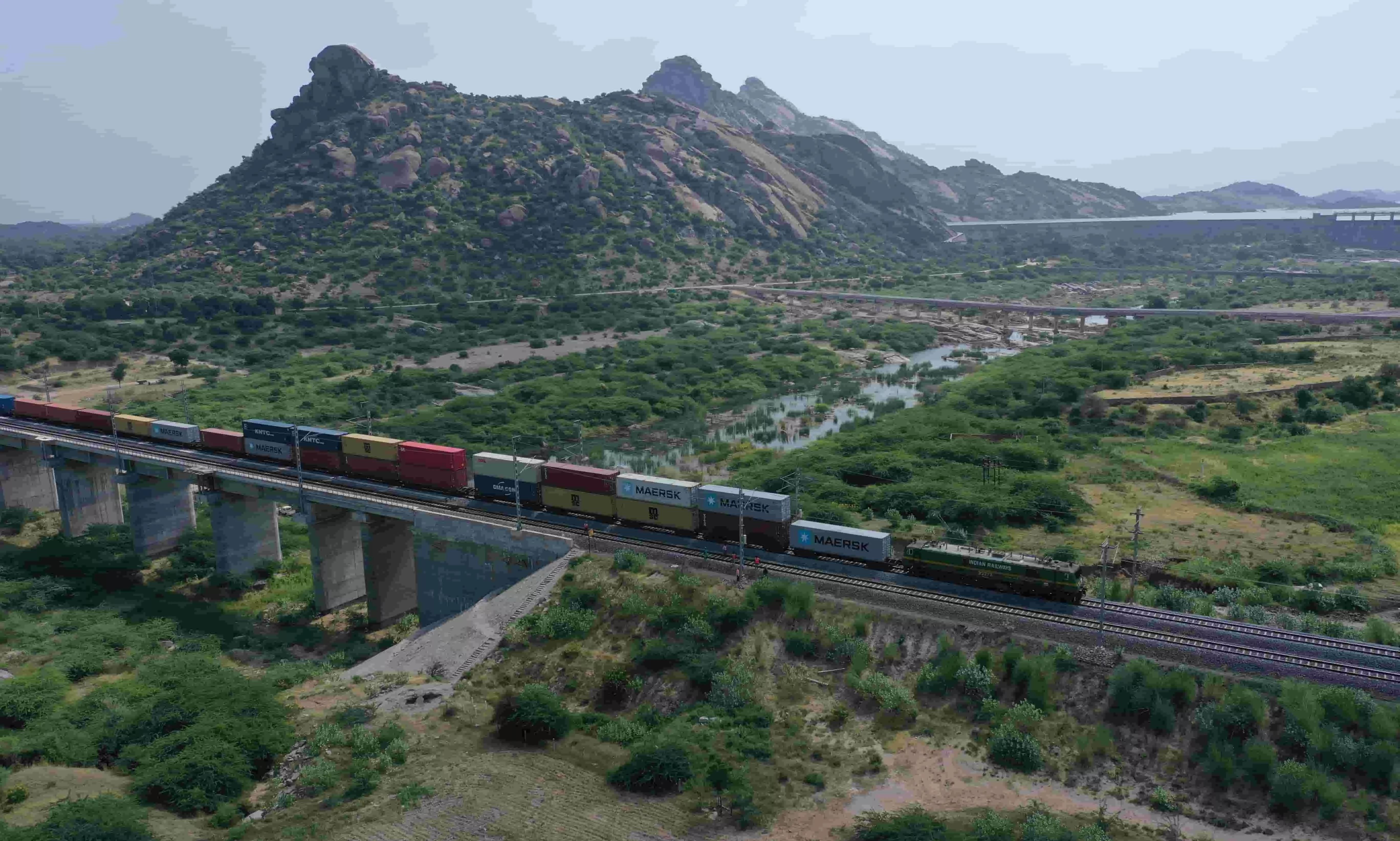Dedicated freight corridors: Transforming India's logistics backbone

Dedicated to advancing India's economic prowess, the 2,843-kilometer Dedicated Freight Corridor network is setting the wheels of transformation in motion. These high-speed corridors are not only slashing cargo transit times and cutting costs but also providing unparalleled freight efficiency. The Eastern Dedicated Freight Corridor (EDFC) stands fully commissioned, while the Western Dedicated Freight Corridor (WDFC) is at 93.2% completion, with the remaining work scheduled for the financial year 2024-25. This infrastructure marvel is fueling the nation's rise as an economic powerhouse across sectors.
As the world's fifth-largest economy with a population of approximately 1.428 billion people, India is eyeing to gain the spot of the world's third-largest economy. With the Indian e-commerce market projected to be worth $ 112.93 billion in 2024 and expected to reach USD 299.01 billion by 2029 (representing a staggering 21.5% CAGR), the nation is rapidly transforming into a growing manufacturing hub. To bolster this rapid economic expansion, a substantial multi-billion dollar infrastructure initiative known as the Dedicated Freight Corridor (DFC) is set to transform the nation's freight transportation sector, solidifying its standing as a logistics powerhouse.
The Dedicated Freight Corridor Corporation of India (DFCCIL) spearheads the DFC project, constructing dedicated freight railways across India. As of 2024, the Eastern and Western Dedicated Freight Corridors, with a combined length of 2,843 kilometers (1,766 miles), are transforming freight movement in the country.
The Western Dedicated Freight Corridor (WDFC) spans 1,506 kilometers, linking the JNPT port in Mumbai to Dadri in Uttar Pradesh, traversing through Maharashtra, Gujarat, Rajasthan, Haryana, and Uttar Pradesh. While the Eastern Dedicated Freight Corridor (EDFC) stretches over 1,337 kilometers, encompassing various sections: Sahnewal to Khurja (401 km), Khurja to Bhaupur (351 km), Bhaupur to DDU (Deen Dayal Upadhyay junction, formerly Mughalsarai) (402 km), DDU to Sonnagar (137 km), and the Khurja to Dadri segment (46 km). “The Eastern Dedicated Freight Corridor (EDFC) is fully commissioned and the Western Dedicated Freight Corridor (WDFC) is also 93.2% completed and the remaining work will be completed in the financial year 2024-25,” said a DFCCIL official in a quote to Indian Transport & Logistics News (ITLN).
These high-speed, heavy-haul electric cargo corridors are not only enhancing freight velocity and reliability but also significantly reducing logistics costs.
The concept of Dedicated Freight Corridors (DFCs) in India was first introduced by the government during the presentation of the Railway Budget for the fiscal year 2005-06. This initiative gained further momentum in April 2005 when it was discussed at the Japan-India Summit Meeting, leading to a declaration of cooperation signed by the Prime Ministers of both nations. This declaration outlined plans for a feasibility study and potential funding for the DFCs from the Japanese Government. By October 2007, the feasibility study report was delivered to India's Ministry of Railways.
Concurrently, the ministry began efforts to create a special-purpose vehicle to manage the construction, operation, and maintenance of the DFCs, resulting in the formation of the Dedicated Freight Corridor Corporation of India Limited (DFCCIL). DFCCIL was entrusted with the responsibility for planning, financial resource mobilisation, construction, operation, maintenance, and business development of the DFCs, marking a significant milestone in the project's implementation.
From DFCCIL's perspective, the Dedicated Freight Corridors are expected to yield transformative impacts on the Indian economy and infrastructure.“The objective of DFC is to reduce the logistics cost below 10% as per the National Logistics Policy. EDFC & WDFC connect the hinterland – land-locked states in the North with the ports of the Western coast. DFC facilitates the speedy movement of goods, the transportation time on EDFC between the coal fields of Eastern India & power stations of North India has decreased from 35 hrs to 20 hrs. The inventory costs of power plants due to significantly reduced transit time have been reduced by 20-30%. Whereas transit time between the ports of Western coasts and the National Capital Region (NCR) has been reduced by more than half.”
The spokesperson highlighted the corridors are "helping agriculture, industry and manufacturing...the MSME sector" by enabling "speedy transportation of perishables like milk, vegetables, fruits, and farm products, thus reducing chances of damages and boosting income for farmers and entrepreneurs. The DFCs are also "giving a boost to supply chain management in the country and harnessing the potential of e-commerce," while "facilitating development of Private Freight Terminals (PFT), Goods Sheds, Inland Container Depots, Multi-Modal Logistics Parks'' aligned with "Gati Shakti Multi-Modal Cargo Terminals (GCT)."
“DFCs offer several advantages that could positively impact logistics operations, including smoother cargo movement, increased capacity, and reduced congestion on roads. These factors could result in lower transportation costs, translating into potential savings that could be passed on to customers or reinvested into improving services. Additionally, the integration of DFCs with multi-modal logistics parks (MMLPs) could further enhance efficiency and streamline operations, potentially reducing overall logistics costs for e-commerce deliveries. However, the extent of cost reductions would depend on various factors such as the volume of shipments, distance covered, and specific operational strategies adopted by Blue Dart in leveraging DFCs for its delivery network,” said Vikram Mansukhani, National Operations Head of Blue Dart.
The DFCCIL is also engaged in discussions with more than a dozen e-commerce and logistics firms, including Amazon, Meesho, Delhivery, Blue Dart Express, and Shiprocket, regarding the leasing of the recently constructed infrastructure for cargo transportation.
The DFC network is increasing capacity within India's rail freight ecosystem, "More than 310 trains are running in both directions," with "speed of freight trains significantly increasing on both EDFC & WDFC."
The spokesperson added that "the length of trains can also be increased" and "double stack container trains also increase the load carrying capacity" on DFC. Innovative offerings like "Trucks-On-Train (ToT) reduces transportation cost & augments modal shift and modal integration," the spokesperson stated. With dedicated freight corridors "decongesting rail tracks," it "helps both passenger & freight train movement" while allowing "introduction of new/special passenger trains." The DFCs aim to "reduce Operations & Maintenance Costs (O&M) of assets" and will "play a crucial role in increasing railways share in total freight to above 40%."
“The scalability of DFCs, with their capacity to handle heavy-haul freight trains daily, ensures that as e-commerce businesses expand, the infrastructure can accommodate increasing shipment volumes without compromising efficiency.”
Vikram Mansukhani, Blue Dart
Constructing a specialised corridor exclusively for rail freight also presented a formidable technological and engineering hurdle for DFCCIL."Difficult terrain has been a challenge, with the DFCs passing through diverse landscapes with gradient challenges. More than 5,000 bridges have been constructed including around 500 major ones across mighty rivers, as well as a 1-km tunnel through the Aravali range connecting the two corridors," according to the DFCCIL spokesperson.
Land acquisition was another formidable task, with DFCCIL securing "11,827 hectares of land across all states, equivalent to over 22,000 football fields." The routes also encountered existing infrastructure like highways that required rerouting to facilitate DFC development. Overcoming technology gaps, workforce training, and pandemic disruptions were other hurdles that have now been overcome.
The construction of DFCs also aimed to ensure sustainable development. "The DFC network is 100% electrified and is harnessing renewable energy through installation of solar panels," highlighted the spokesperson. Measures like rainwater harvesting, tree plantation drives with over 22,000 trees planted for green belts, recycling waste materials, using energy-efficient appliances, constructing camouflaged bridges and fenced barricades for wildlife protection have been implemented.
The spokesperson added that "noise barriers have been erected at sensitive locations" while the "Trucks-On-Train service helps save on fuels." Significantly, "DFC will reduce 457 million tonnes of carbon dioxide emissions in its first three decades of operations."
Looking ahead, DFCCIL has an ambitious future roadmap. "The future DFC network projects have received approval, including the East-West, East Coast, and North-South Dedicated Freight Corridors, while a Southern DFC has also been proposed."
With the corridors developed along the Golden Quadrilateral, they "bolster modal shift, decongest roads and promote an economical freight movement through railways." The integrated multi-modal logistics parks along DFC routes enhance inter-modal synergies. "Quicker transit times and bulk transportation translate into reduced per-unit logistics costs benefiting all stakeholders," while "a level crossing free DFC eliminates accident risks and freight disruptions."
“The scalability of DFCs, with their capacity to handle heavy-haul freight trains daily, ensures that as e-commerce businesses expand, the infrastructure can accommodate increasing shipment volumes without compromising efficiency. Moreover, the cost savings generated by using rail networks instead of roadways can be reinvested by e-commerce companies to improve services or reduce consumer prices, driving further growth in the sector,” said Vikram of Blue Dart.
The completion of India's dedicated freight corridors represents a monumental achievement and ushers in a new era of efficient and sustainable logistics for the nation. These marvels of engineering have not only alleviated the burden on the country's overstretched rail network but have also paved the way for an economic renaissance. The corridors have become the arteries that pump life into industries, facilitating the seamless movement of goods and raw materials across vast distances.
As these corridors continue to expand, their impact will reverberate through every sector of the economy, from agriculture to manufacturing. Farmers will find new markets for their produce, as the reduced transportation costs and faster delivery times open up previously inaccessible regions. Industries, too, will benefit from the reliable and cost-effective movement of supplies, enabling them to remain competitive in the global marketplace.
As the nation looks ahead, the dedicated freight corridors stand as a symbol of resilience, innovation, and progress. They have not only transformed the way goods move across the country but have also set the stage for India to emerge as a global manufacturing and logistics hub.

Parijat Sourabh
As a news correspondent at STAT Media Group, I cover stories on logistics, aviation, and air cargo. Feel free to contact me at parijat@statmediagroup.com


